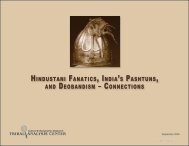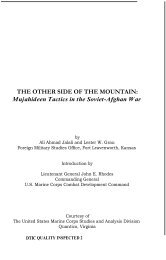the baluch and the brahui and their rebellions - Tribal Analysis Center
the baluch and the brahui and their rebellions - Tribal Analysis Center
the baluch and the brahui and their rebellions - Tribal Analysis Center
Create successful ePaper yourself
Turn your PDF publications into a flip-book with our unique Google optimized e-Paper software.
The Baluch <strong>and</strong> <strong>the</strong> Brahui - <strong>and</strong> <strong>the</strong>ir RebellionsThe Baluch <strong>and</strong> <strong>the</strong> Brahui – <strong>and</strong> <strong>the</strong>ir Rebellions“…Such a system might work well so long as <strong>the</strong>re was a strong ruler in Kalat, butonce his power diminished, <strong>the</strong> natural result was civil war…”R. Hughes-Buller, 1901The gate of Kalat ca. 1910The tribes inhabiting Baluchistan came under <strong>the</strong> identical pressures influencing <strong>the</strong> tribes of Afghanistan during <strong>the</strong>ir violent histories. Livingat <strong>the</strong> crossroads of Central Asia had one great disadvantage, <strong>and</strong> this involved <strong>the</strong> repeated <strong>and</strong> serial invasions by migrating tribes pressed from <strong>the</strong>iroriginal homel<strong>and</strong>s <strong>and</strong> armies bent upon conquest. Generally, <strong>the</strong>se invasions came from <strong>the</strong> west – along <strong>the</strong> same route of <strong>the</strong> tribal migrations. Insou<strong>the</strong>rn Afghanistan, individual tribes began to organize <strong>the</strong>mselves into larger aggregations in hopes of defending <strong>the</strong>mselves against <strong>the</strong> repeatedthreats emerging from <strong>the</strong> west of <strong>the</strong>ir tribal areas. Only <strong>the</strong> armies of Alex<strong>and</strong>er <strong>the</strong> Great entered <strong>the</strong> region using <strong>the</strong> “nor<strong>the</strong>rn route,” <strong>and</strong> evenhe chose <strong>the</strong> more obvious sou<strong>the</strong>rn route as his men struggled to depart from Central Asia. The terrain of <strong>the</strong> south, less <strong>the</strong> large desert areas, wasan ideal invasion route <strong>and</strong> army after army used it.The Baluch tribes also migrated into <strong>the</strong> region from <strong>the</strong> west. Their traditions say <strong>the</strong>y originated from <strong>the</strong> vicinity of Aleppo, Syria, whilescholars studying comparative linguistics suggest <strong>the</strong>ir origin in an area of <strong>the</strong> Caspian Sea, possibly a waypoint with extended residence before beingpressed fur<strong>the</strong>r east by <strong>the</strong> arrival of more aggressive migrants. Regardless, <strong>the</strong> Baluch tribes were present in Baluchistan in 1000 A.D. <strong>and</strong> werementioned in Firdausi’s book, Shahnamah (<strong>the</strong> Book of Kings), <strong>and</strong> like all invading armies <strong>the</strong>y were described as being aggressive, “like battlingrams all determined on war.” 1As <strong>the</strong> last of <strong>the</strong> migrating tribes to arrive, <strong>the</strong> Baluch had to displace or assimilate <strong>the</strong> tribes that were already present <strong>and</strong> occupying <strong>the</strong> l<strong>and</strong>.Opposed by <strong>the</strong> powerful Brahui 2 tribes, <strong>the</strong> Baluch were able to overcome <strong>the</strong>m until an extended civil war broke out between <strong>the</strong> Rind <strong>and</strong> LashariBaluch tribes which weakened <strong>the</strong>m substantially.After defeating <strong>the</strong> Brahui under <strong>the</strong>ir chief, Mir Chakar of <strong>the</strong> Rind tribe in approximately 1487, <strong>the</strong> Baluch kingdom was destroyed in <strong>the</strong> 30-year civil war between <strong>the</strong> Rind tribe <strong>and</strong> its rival, <strong>the</strong> Lasharis. The Baluch had exp<strong>and</strong>ed eastward as <strong>the</strong>y spread into modern Pakistan’s Sind <strong>and</strong>1. www.geocities.com/pak_history/<strong>baluch</strong>istan.html accessed on 15 August 2009.2. The Brahui tribes were probably in <strong>the</strong> region long before <strong>the</strong> arrival of <strong>the</strong> migrating series of invaders from <strong>the</strong> east <strong>and</strong> may have been <strong>the</strong> original inhabitants of <strong>the</strong> region.Alone among <strong>the</strong> region’s inhabitants, <strong>the</strong> Brahui speak Dravidian, a language found deep within India.<strong>Tribal</strong> <strong>Analysis</strong> <strong>Center</strong>, 6610-M Mooretown Road, Box 159. Williamsburg, VA, 23188
















